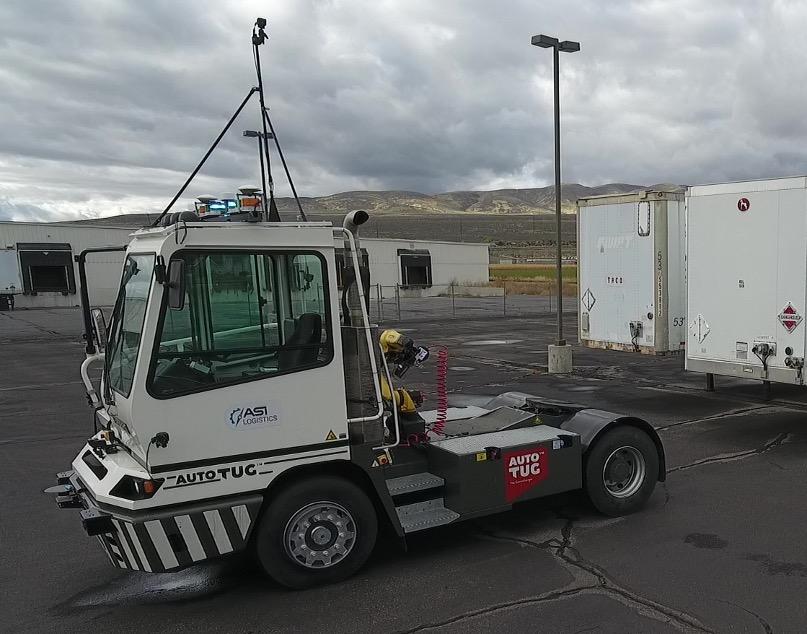
ASI Logistics and SICK, Inc. announce another milestone in the development
of autonomous yard truck operations. Together, they solved the issue of
reversing into trailers autonomously. Autonomously reversing into trailers
is one of the final steps in completing fully autonomous yard truck
operations. ASI Logistics utilized its robust Vehicle Automation Kit (VAK)
and SICK’s industry-leading LiDARs to overcome this challenge.
Aaron Rothmeyer, Product Manager for SICK, spoke on the importance of LiDAR
in autonomy: “SICK recognizes that better autonomous vehicles are only
possible with better sensing technologies. As such, SICK is continually
innovating its product portfolio to take advantage of the latest tools and
ideas. Their substantial experience with optical devices shows up in
well-designed sensors all the way down to the component level. In addition,
SICK is also heavily involved in the creation and updating of global safety
standards which is a critical step to ensuring autonomous vehicles’
continued success.”
HOW IT WORKS
For autonomously reversing into trailers to operate correctly a few
technical details must be known. The autonomous trucks must know the
position and height of the trailer’s kingpin it is reversing into. The
kingpin is the mechanism under the trailer that connects to the truck’s
fifth wheel and locks the trailer to the truck. The truck must be able to
command the kingpin connection, and the truck must be commanded to reverse
autonomously into trailers.
ASI Logistics leverages a state-of-the-art VAK to control its autonomous
yard trucks. Inside the VAK is the truck’s Vehicle Control Unit (VCU). The
VCU commands all the truck’s functions when the truck is in autonomous mode.
Relying on quality data transmission from the sensors to the VCU is key to
reversing into trailers autonomously. ASI utilizes two SICK LiDARs, the
LMS1000 for kingpin position, and the TIM551 for kingpin height.
SICK has been developing optical products for industrial applications since
1946. With 75 years of experience working in rugged environments, SICK
delivers quality data even when conditions aren’t always ideal. SICK’s
LiDARs use light detection and ranging to target objects with a laser and
measure the time that passes until the reflected light returns to the
receiver. This means LiDAR sensors are capable of generating a 3D or 2D
image with spatial and depth data for detecting, measuring, localizing, and
tracking objects. LiDAR sensors installed in robot arms, manned forklifts,
and yard trucks provide greater efficiency, accuracy, and safety by
simplifying and optimizing handling, transport, loading and unloading, and
material storage.
As the truck reverses, the two LiDARs detect where the trailer’s kingpin is
and relay this information to the truck’s VCU. The VCU then commands the
throttle, brakes, steering, and fifth wheel to continue to reverse safely
into the trailer until a secure and safe connection to the kingpin is made.
Once the connection is made, sensors indicate that the truck has a secure
connection and is now ready for the robotic arm to attach the necessary
glad-hands and continue with the rest of the move.
This whole process is completed using ASI’s Mobius software. Mobius is the
most advanced command and control software for autonomous vehicles in the
world and is backed with over 20 years of industry experience and has
millions of data testing hours behind it. Mobius shows real-time vehicle
movement, vehicle state, kingpin alerts, and robotic arm control all from a
user that can be on-site or anywhere in the world.
ASI’s Mobius combined with SICK’s LiDARs offer huge potential to
continuously deliver the most advanced autonomous yard truck solutions in
the world.
About ASI:
Autonomous Solutions, Inc. (ASI) is a world leader in industrial vehicle
automation. ASI serves clients across the world in logistics, mining,
agriculture, automotive, government, and manufacturing industries with
remote control, teleoperation, and fully automated solutions from its
headquarters and 100-acre proving ground in northern Utah.
About SICK:
Founded in 1946, SICK is one of the world’s leading solutions providers for
sensor-based applications in the industrial sector. From factory automation
to logistics automation and process automation, SICK’s sensor solutions are
keeping the industry moving. As a technology and market leader, SICK
provides sensor intelligence and application solutions that create the
perfect basis for controlling processes securely and efficiently, protecting
individuals from accidents, and preventing damage to the environment.



More Stories
Accelerating The Development of Hydrogen Vehicles & Infrastructure – Europe’s Biggest Players Meeting at Premier Event
Automotive IQ Announces the 15th Annual Automotive Functional Safety Week 2025
Major Automotive Companies to Share Latest Developments in Steering, Braking, Chassis and Suspension Systems at Premier Industry Event